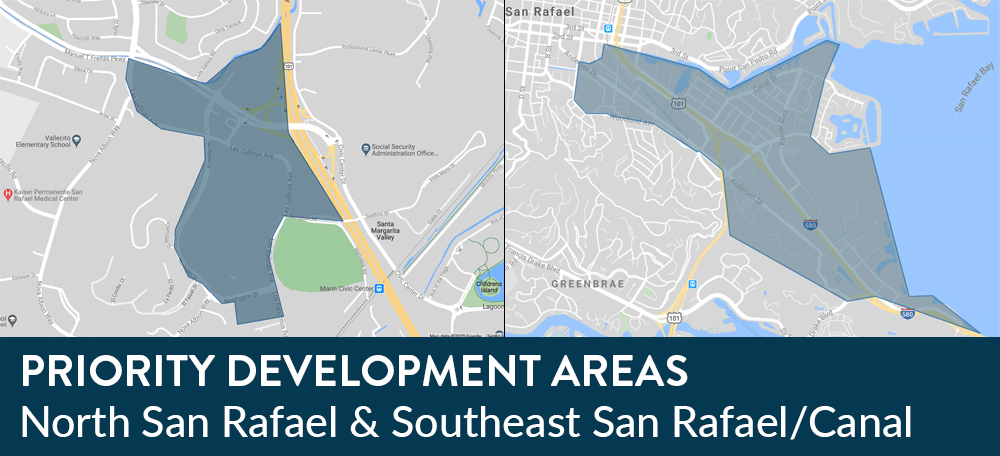While there are similarities and overlap, each Plan type is distinctive and have different elements and purposes. The purpose of all these plans to is conduct future planning. The different plans look at a finer level of detail for future planning a specific geographic area. The following is a description of each Plan type and how they differ. Plan types are listed from most detailed to least detailed:
Specific Plan. A Specific Plan is the most detailed of these plans and is defined and regulated by the State of California (State Government Code Sections 65450-65457). What is unique about a Specific Plan is that it combines a policy document (ex. goals, policies and programs) with a regulatory document (zoning ordinance). Specific Plans serve as a standalone planning document, replacing the General Plan and citywide zoning ordinance for the Specific Plan area. By law, a Specific Plan is required to include:
- land use regulations and development standards;
- a program of implementing measures;
- planned and needed public works projects to serve the Specific Plan area (essentially a capital improvement program); and
- financing measures necessary to implement the Plan and its recommendations.
A Specific Plan is subject to environmental review under the California Environmental Quality Act (CEQA). CEQA often requires the preparation of an Environmental Impact Report (EIR). This EIR is required to have a greater level of detail and study than an EIR prepared for a General Plan.
Due to the detail of the EIR for the Specific Plan, State laws provide environmental review streamlining and exemptions. This streamlining and exemptions are only available for development projects (particularly housing projects) if they are consistent with the Specific Plan.
Precise Plan. A Precise Plan is like a Specific Plan but more loosely defined. Unlike a Specific Plan, the format and content of a Precise Plan can vary. A Precise Plan usually will contain the same elements and content as a Specific Plan but will lack a financing component and capital improvement program. These elements describe how and when Plan implementation will be funded. Further, unlike a Specific Plan, a Precise Plan remains under the umbrella of a citywide General Plan.
For example, the City is currently developing a Downtown San Rafael Precise Plan. This Precise plan will include all of the elements and content of a Specific Plan (including a zoning ordinance), but does not include a financial component.
A Precise Plan is subject to environmental review (CEQA) preparation of an Environmental Impact (EIR) that has a greater level of detail and study than an EIR prepared for a General Plan. Therefore, it can offer environmental review streamlining for development projects that are determined to be consistent with the Precise Plan.
Community Plan. A Community Plan is a part, or “Element,” of a local General Plan focusing on a particular area of the community within the local jurisdiction. A Community Plan is a policy document that supplements the local General Plan. A Community Plan presents goals, policies and programs that are specific and unique to the community or area that it covers. Unlike a Specific Plan or a Precise Plan, a Community Plan is not a regulatory document. Community Plans do not include zoning regulations or development standards.
A Community Plan is subject to environmental review (CEQA). This review may be covered by an Environmental Impact Report (EIR) prepared for the General Plan or by its own EIR. Typically, the EIR that covers a Community Plan assesses environmental impacts at a general level which is not site specific.
Development projects in an area covered by a Community Plan must be reviewed to determine if the project is expemt from environmental review. This review is based on the specific site conditions and potential impacts. Exemptions are allowed if the project meets specific criteria. The criteria must be documented through the preparation of an “Initial Study” checklist.
Neighborhood Plan. A Neighborhood Plan is like a Community Plan but is more loosely defined. The detail, content and scope of a Neighborhood Plan can vary significantly. Neighborhood plans typically include a vision, data and demographics, mapping goals and objectives, and an action plan. Like a Community Plan, it is a policy document that supplements the local General Plan and does not include zoning regulations or development standards.
As a Neighborhood Plan may or may not be subject to environmental review (CEQA) depending on the content and scope. For example, a Neighborhood Plan formatted as a “vision document” and includes a list of future actions, is considered a planning study. As a planning study it is not subject to environmental review.
Master Plan. The term “Master Plan” is broadly defined in its use and has no one, specific purpose or standing. In some jurisdictions, the local General Plan is referred to as a Master Plan. However, most commonly, a Master Plan is a planning tool that typically covers a smaller, more localized area or a single site. A Master Plan will typically will include zoning regulations and development standards. Master Plans will include a graphic, conceptual layout of the plan area. The conceptual layout identifies allowable land uses and expected development for the Plan area. Being under the umbrella of the local General Plan, a Master Plan cannot be adopted unless it is determined to be consistent with the General Plan.
If a Master Plan is structured to serve as the regulatory zoning document for a specific area, it is subject to environmental review under CEQA. An EIR that is prepared for a Master Plan has a greater level of detail and study. If a development project is consistent with the Master Plan they can be exempt from or subject to a limited environmental review.


